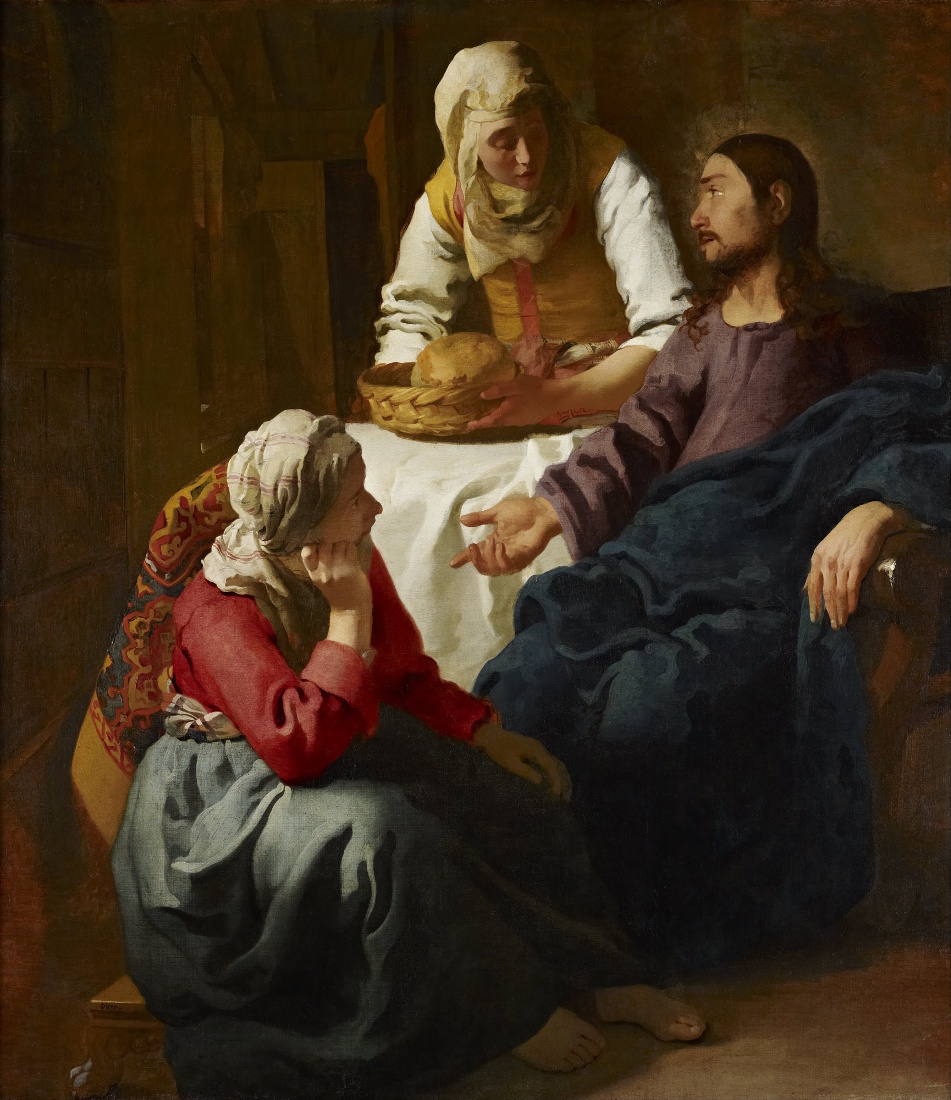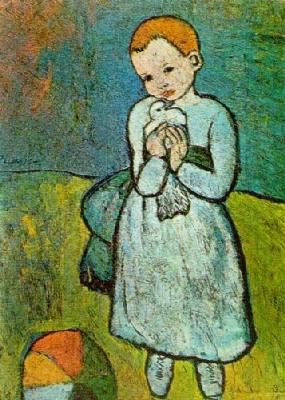 Now I have to say at the start of this post – it won't appeal to everyone's theological interests; it's a bit obscure; you may end up wondering "what's the point, Jim"? So if you're not into reflection on the connections between art and Trinitarian theology, aesthetics and dogmatics, human creativity and contingency on the one hand and Divine creativity and eschatological telos on the other (I speak anthropomorphically!), then if you've had enough already, click elsewhere now!
Now I have to say at the start of this post – it won't appeal to everyone's theological interests; it's a bit obscure; you may end up wondering "what's the point, Jim"? So if you're not into reflection on the connections between art and Trinitarian theology, aesthetics and dogmatics, human creativity and contingency on the one hand and Divine creativity and eschatological telos on the other (I speak anthropomorphically!), then if you've had enough already, click elsewhere now!
What I have in mind touches on a number of strategically placed theological flying buttresses: imago dei, creation, providence, the Triune nature of God and the incarnation. I got to thinking all this when reading an essay entitled Art: A Trinitarian Imperative by Brian Horne. The main argument is that there is that in human nature and existence which is compelled to create, to express, to articulate in sound or vision, in music, word, image or object, to bring into existence that which is born within. The image of God in human being and experience is expressive; and this for two reasons.
 First, the incarnate Word is the revelation of the kenotic outgoing love, enfleshed in a human life, made material, a true representation of the imago dei. The human artist exhibits the imago dei, and echoes the materiality of the incarnation in the musical notation of the concerto, the accumulated precision of brush strokes, the toilsomely shaped sculpture, the organisation of letters and words into meanings articulated, communicated and more or less comprehended. Secondly, and this is Horne's point, such a process, expressive of the divine radiance, is the human will responding freely to the movement of the Holy Spirit.' In other words art is an inner impetus towards creation originating in the human imaging of God, but that impetus and its creative expression in aesthetic articulation is the work of the Spirit of God, the creative, formative power of a love that brings into being.
First, the incarnate Word is the revelation of the kenotic outgoing love, enfleshed in a human life, made material, a true representation of the imago dei. The human artist exhibits the imago dei, and echoes the materiality of the incarnation in the musical notation of the concerto, the accumulated precision of brush strokes, the toilsomely shaped sculpture, the organisation of letters and words into meanings articulated, communicated and more or less comprehended. Secondly, and this is Horne's point, such a process, expressive of the divine radiance, is the human will responding freely to the movement of the Holy Spirit.' In other words art is an inner impetus towards creation originating in the human imaging of God, but that impetus and its creative expression in aesthetic articulation is the work of the Spirit of God, the creative, formative power of a love that brings into being.
 This is an exciting line of thought for me. two of my main interests in theology are exploring the tradition of Christian Trinitarian thought, and seeking connections between art and theology. Horne is arguing that the divine mystery of the Trinity involves the radical immanence of the Holy Spirit, the ultimate transcendence of the Father, and 'the union of these two modes of being in the expressive form of the Incarnate Son. And from that Trinitarian standpoint he concludes that the Holy Spirit and human inspiration towards expressive art, are deeply and intentionally related in the essential created and creative nature of human beings. Quoting Von Balthasar whose pneumatology affirms the role of the Spirit as the on who mediates the glory of God, "Since the Spirit Himself is the glorification of the love between thre Father and the Son, wherein God's true glory disclosed itself to us, it is likewise only he who can bring about glorification in the world."
This is an exciting line of thought for me. two of my main interests in theology are exploring the tradition of Christian Trinitarian thought, and seeking connections between art and theology. Horne is arguing that the divine mystery of the Trinity involves the radical immanence of the Holy Spirit, the ultimate transcendence of the Father, and 'the union of these two modes of being in the expressive form of the Incarnate Son. And from that Trinitarian standpoint he concludes that the Holy Spirit and human inspiration towards expressive art, are deeply and intentionally related in the essential created and creative nature of human beings. Quoting Von Balthasar whose pneumatology affirms the role of the Spirit as the on who mediates the glory of God, "Since the Spirit Himself is the glorification of the love between thre Father and the Son, wherein God's true glory disclosed itself to us, it is likewise only he who can bring about glorification in the world."
The idea that human art and expressiveness is inspired by, has its origins in the Holy Spirit, and echoes the divine creative impulse towards that which is loved, an urgent love which dwells in and flows from the eternal communion of the Triune God, is a powerful theological argument for artistic expression, skilled manufacture, and the sanctification of the impulse to create that which is beautiful, true and good. Horne finishes this intriguing essay:
"Since self-expressive energy has been revealed to us as the very structure of the life of God, it cannot be an activity which is optional in the life of creatures who are made in that image: it is a Trinitarian imperative. We may not choose not to create if we are to be human."
 In answer to the imagined question at the start of the post, "That's my point, Jim". The Triune God of love, in whose image we are created, by whose love we are redeemed, and by whose Spirit we live and move and have our being, empowers and enables that which, in the words of a dear friend, words she uses often to end her prayers, 'Lord, bless us and make us for blessing, and wholeness and joy" Amen to that sister!
In answer to the imagined question at the start of the post, "That's my point, Jim". The Triune God of love, in whose image we are created, by whose love we are redeemed, and by whose Spirit we live and move and have our being, empowers and enables that which, in the words of a dear friend, words she uses often to end her prayers, 'Lord, bless us and make us for blessing, and wholeness and joy" Amen to that sister!
The photos on this post were taken in Amsterdam and Vienna. Van Gogh's bedroom is for me one of the most poignant and joyful portrayals of home, not only as place, but as safe space and comfortable place. The butterfly, that fragile glory of life that images transformation and resurrection, is a photo I waited a long time to take, because butterflies are not the most obliging models of God's created masterpieces. The close-up of Raphael's Madonna of the Meadows tries to capture, and all too inadequately, the most beautiful face I have seen on canvas. And the statue of Mozart in Vienna, overlooking the musical flower bed, gave me a photo that in its own quirky way celebrates a musician whose music is one of the aesthetic wonders of the world, and will be, according to one of my best friends, 'the music played in heaven.' I can go with that – Mozart's music, oh and maybe some Tallis, and Beethoven, and….well, heaven's a big place and time isn't a problem, let's just wait and see, and hear, and touch, and smell, and all to our taste.
As often, when I am looking for words of substance I turn to poetry from one of those poets who have been my companion for a long time. Denise Levertov is one whose work I have read and pondered, for a long time. Some of it is worth pondering, some was so immediate, so woven with context that its fabric quickly fades with time. One reason Levertov is to be cherished is that, at her best, her poetry has a long view, she understands the importance of time and patience in the formation and growth of hope. This was a woman who wore her heart on her sleeve, and who wrote her heart in her poems. And the longer life went on the more she became a poet whose political and ethical vision burned with moral passion and compassion. From her opposition to the Vietnam war, the atrocities in Cambodia, El Salvador, Iraq, and global threats of nuclear armaments, ecological crises and economic injustices, she wrote with anger, pity, love, and with hope. For Levertov, hope is inherently patient, involves waiting, summons us to take the long view, literally, longing for hope.



